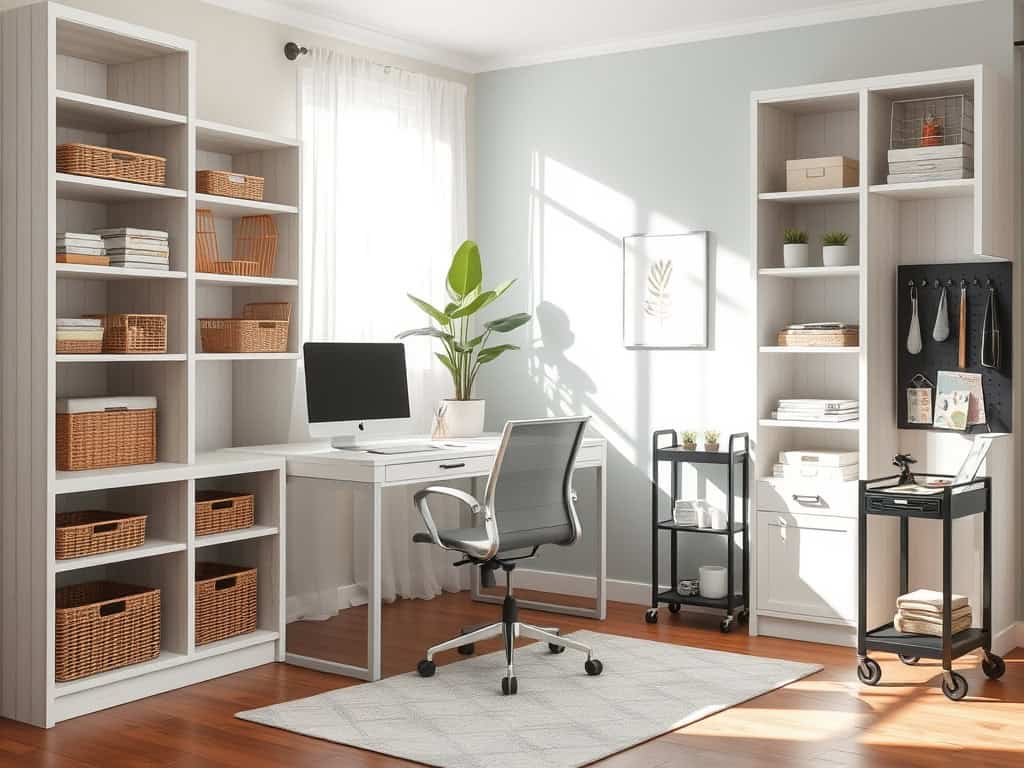Just like a jigsaw puzzle where every piece has its perfect place, an organized home office can transform your daily workflow from chaos to calm. If you’re tired of shuffling through stacks of papers or hunting for that one USB cable that seems to vanish into thin air, you’re not alone! I’ve discovered nine clever storage solutions that’ll help you reclaim your workspace and boost your productivity. Let’s explore how these game-changing ideas can turn your cluttered corner into a streamlined sanctuary.

Wall-Mounted Floating Shelves and Cable Management
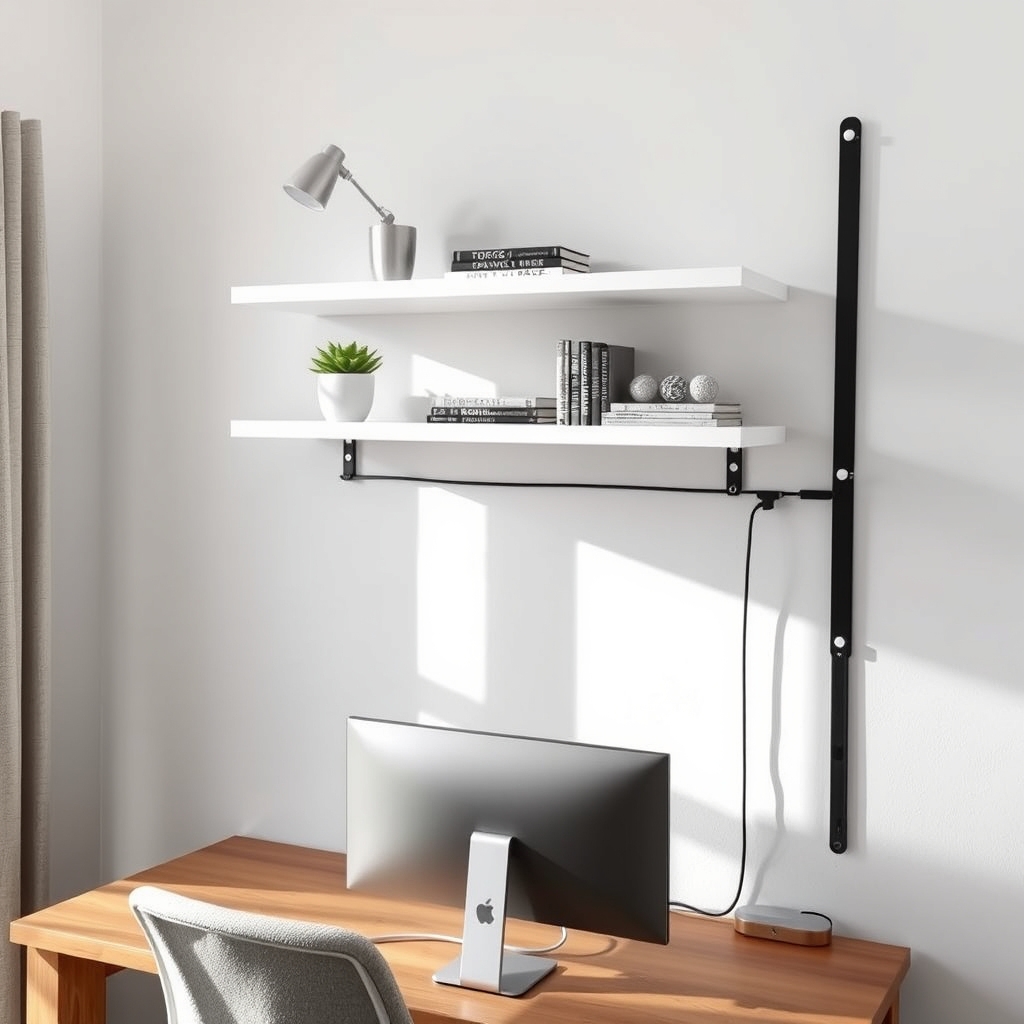
A well-organized home office setup with strategically placed floating shelves and properly managed cables creates a clean, professional workspace that maximizes both functionality and aesthetics. Wall-mounted shelves free up valuable desk space while keeping essential items within arm’s reach, contributing to improved workflow and productivity.
Cable management is equally crucial, as tangled wires not only create visual clutter but can also pose safety hazards and make equipment maintenance difficult. A properly organized cable system ensures easy access to power sources, reduces wear and tear on cords, and maintains a polished, professional appearance in your home office.
Required Items:
- Floating shelves
- Wall anchors and screws
- Stud finder
- Level
- Drill
- Cable management tracks
- Cable ties
- Adhesive cable clips
- Cable sleeves
- Surge protector
- Label maker
- Measuring tape
- Pencil
Begin the organization process by mapping out your shelf placement using a stud finder and level. Install floating shelves at appropriate heights, ensuring they can support your intended weight load. Position frequently used items on lower shelves and less-used items higher up.
For cable management, start by unplugging all devices and grouping cords by function (computer, printer, lighting, etc.). Install cable management tracks along the desk’s edge or wall, and thread cables through them.
Use adhesive cable clips to secure individual cords along a planned route, keeping them hidden when possible. Bundle related cables together using cable ties or sleeves, leaving enough slack for movement but eliminating excess length. Position your surge protector in an accessible location, preferably mounted under the desk or on a wall to keep it off the floor.
For optimal organization maintenance, label both ends of each cable for easy identification during future changes or troubleshooting. Consider leaving extra slack in cables stored in a small loop behind equipment for future adjustments, and always maintain at least a few inches of separation between power cables and data cables to prevent interference.
Regularly inspect cable conditions and adjust organization systems as your office needs evolve.
Multi-Purpose Furniture With Hidden Storage
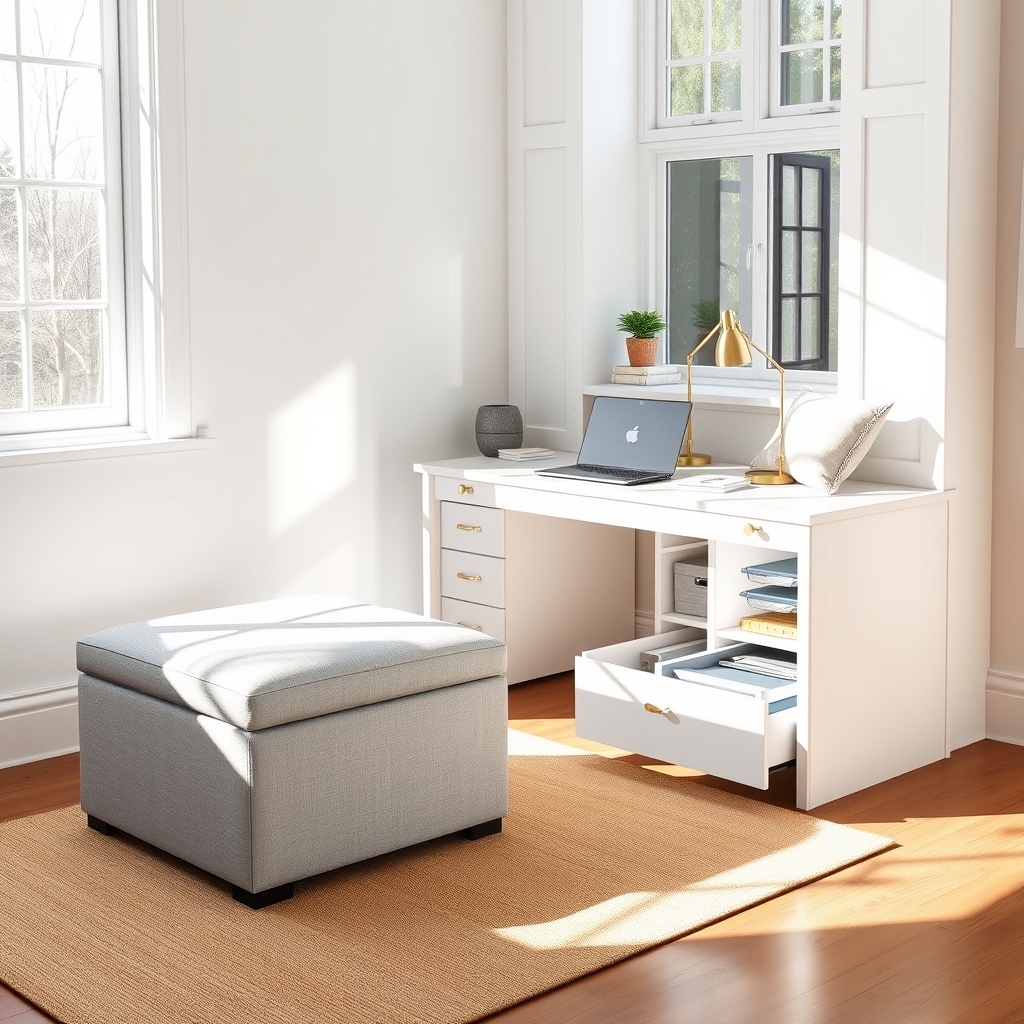
In today’s compact living spaces, maximizing every square foot has become essential, particularly in home offices where work materials and supplies can quickly create clutter.
Multi-purpose furniture with hidden storage offers an elegant solution to maintain a professional workspace while keeping necessary items within arm’s reach but out of sight.
Strategic organization of multi-purpose furniture not only creates a cleaner aesthetic but also improves workflow efficiency. When storage is thoughtfully integrated into functional pieces, you can maintain a minimalist environment while having immediate access to important documents, supplies, and technology.
Required Items:
- Ottoman with storage compartment
- Desk with built-in drawers or shelving
- Bench seating with storage space
- Filing boxes or containers
- Label maker
- Storage bins in various sizes
- Drawer organizers
- Cable management solutions
- Shelf dividers
- Clear storage containers
Start by assessing your furniture pieces and identifying all available hidden storage compartments. Sort items into categories based on frequency of use, with daily essentials stored in easily accessible areas.
Utilize ottoman storage for larger items or reference materials, and maximize desk drawers with organizers for smaller supplies. Install shelf dividers in bench storage to create designated spaces for different categories of items.
For optimal organization, implement a zone system within each piece of furniture. Reserve the top desk drawer for frequently used items, middle drawers for current projects, and bottom drawers for archival materials.
Use clear containers within larger storage spaces to prevent items from becoming jumbled, and always label containers clearly to maintain organization long-term.
Additional Tip: Create a quarterly maintenance schedule to review and reorganize hidden storage areas. This prevents accumulation of unnecessary items and ensures the system continues to serve your needs effectively.
Consider using vacuum storage bags for seasonal items stored in larger furniture pieces to maximize space and protect contents from dust and moisture.
Vertical Filing Systems and Document Organization

A well-organized vertical filing system serves as the backbone of an efficient home office, transforming chaos into order and saving countless hours of searching for important documents. When papers and files are properly organized vertically, they not only save valuable desk space but also create a visual system that makes document retrieval quick and intuitive.
Vertical filing maximizes the use of wall space and keeps documents visible and accessible, reducing the tendency to create messy stacks of papers. This organization method helps maintain a clutter-free workspace while ensuring important documents remain protected and easy to locate when needed.
Required Items:
- Wall-mounted file holders
- Hanging file folders
- File folder labels
- Label maker or marker
- File box or cabinet
- Document sorting trays
- Paper clips and binder clips
- File folder tabs
- Filing category dividers
- Archive boxes
Start by sorting all documents into broad categories such as financial, personal, work, and household. Install wall-mounted file holders at eye level, ensuring they’re securely anchored. Create a clear labeling system using consistent terminology and color coding for different categories.
Set up hanging files within each section, arranging them alphabetically or chronologically depending on your needs. Establish a front-to-back system where newer documents are placed in front of older ones within each category.
Place frequently accessed files at eye level in the most accessible locations. Create a logical flow from left to right or top to bottom, depending on your wall-mounted system configuration. Include a separate section for action items or pending documents that require immediate attention.
For optimal organization maintenance, implement a regular filing schedule, such as weekly document sorting and monthly system review. Consider scanning important documents for digital backup, and establish a clear retention policy for different document types.
Purge unnecessary papers regularly and maintain an index of your filing system for quick reference. Remember to position your vertical filing system within arm’s reach of your primary workspace to encourage consistent use.
Under-Desk Storage Solutions and Drawer Units
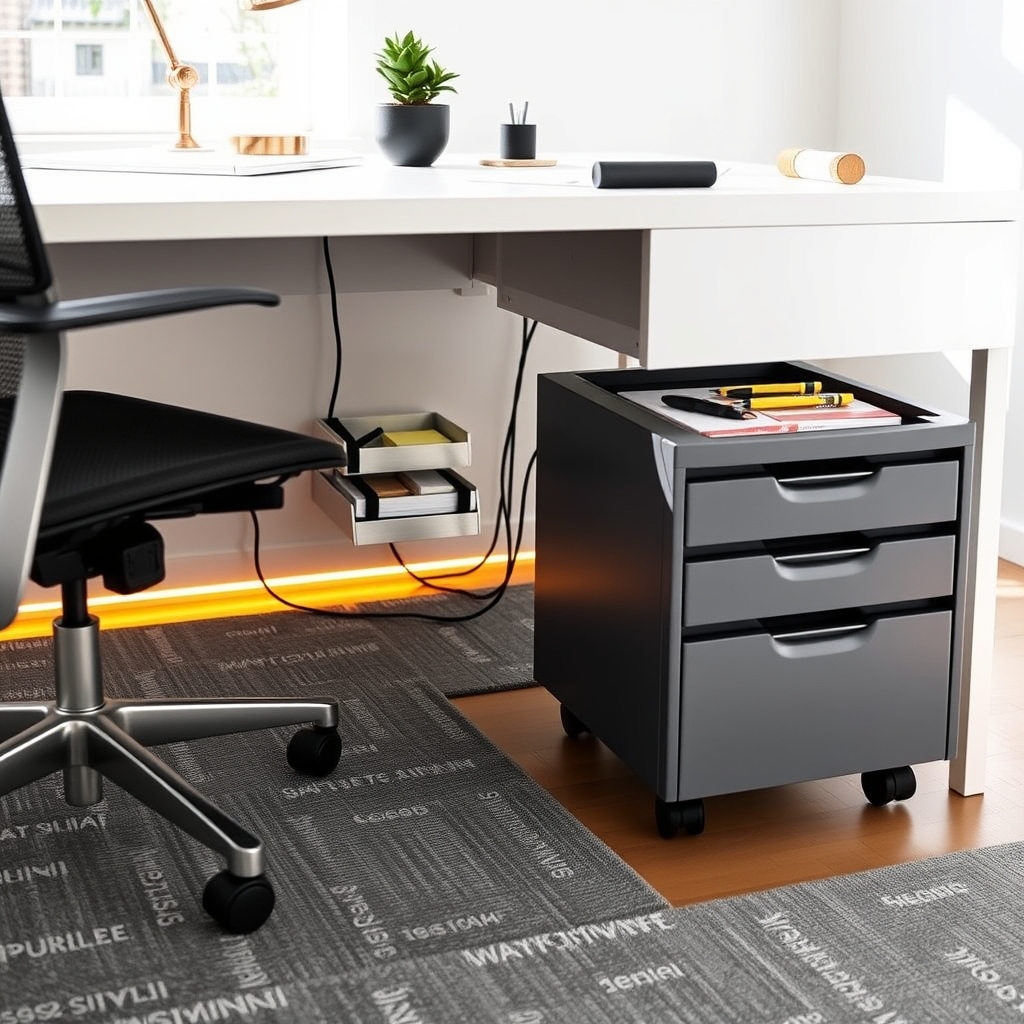
A well-organized under-desk area serves as the foundation for a productive workspace, directly impacting workflow efficiency and reducing time spent searching for essential items. Proper storage solutions beneath your desk can maximize valuable square footage while keeping frequently used items within arm’s reach.
Creating an organized under-desk storage system eliminates clutter, reduces stress, and maintains a professional appearance in your home office. Strategic placement of drawer units and storage solutions can transform dead space into functional storage while ensuring comfortable leg room and proper ergonomics.
Required Items:
- Rolling drawer unit
- Cable management clips or ties
- File folders
- Drawer organizers or dividers
- Label maker
- Measuring tape
- Storage boxes
- Under-desk mounting brackets
- Shelf risers
- Anti-slip mat
Start by measuring your under-desk space, accounting for leg room and chair movement. Position your rolling drawer unit on the side that corresponds with your dominant hand for easy access.
Install cable management solutions first, ensuring all wires are properly secured and organized against the desk’s underside. Group similar items together in designated drawers, using organizers or dividers to maintain separation.
For optimal organization, dedicate the top drawer to frequently accessed items like writing tools and notepads. Use the middle drawer for filing systems and current projects. Reserve bottom drawers for less-frequently used items or backup supplies.
Mount additional storage solutions, such as pencil trays or small shelves, to the desk’s underside where appropriate, ensuring they don’t interfere with leg movement.
Additional Tips: Implement a quarterly review system to prevent accumulation of unnecessary items and maintain organization. Use clear containers or label everything for easy identification.
Consider adding LED strip lighting under the desk to illuminate storage areas, and maintain a small gap between storage units for proper air circulation and ease of cleaning.
Corner Space Optimization With Custom Built-Ins
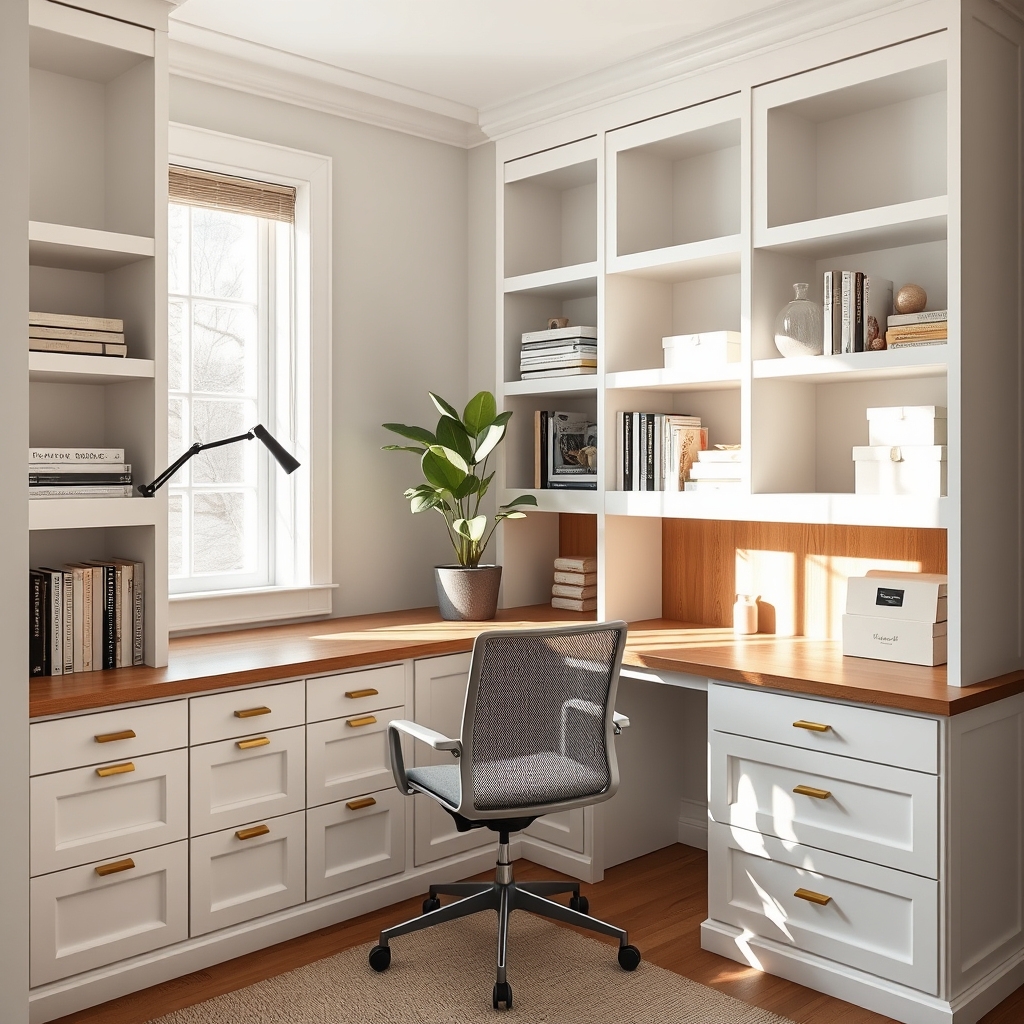
Maximizing corner spaces in home offices has become increasingly crucial as more people transition to remote work. These often-overlooked areas can be transformed into highly functional workspaces that significantly increase storage capacity and improve workflow efficiency. Corner built-ins offer a seamless solution that can accommodate various work needs while maintaining a professional aesthetic.
Custom built-ins specifically designed for corner spaces eliminate the awkward angles and wasted space typically associated with standard furniture arrangements. When properly planned and executed, these installations can incorporate everything from file storage and printer stations to display shelves and hidden cable management systems, creating a cohesive and organized workspace that optimizes every square inch.
Required Items:
- Measuring tape
- Level
- Pencil and paper for sketching
- Basic carpentry tools
- Wood materials (plywood, lumber)
- Hardware (brackets, screws, hinges)
- Paint or finish materials
- Cable management solutions
- Lighting fixtures
- Storage containers
- File organizers
The organization process begins with a thorough assessment of your corner space, measuring both the available width and height, and noting any electrical outlets or architectural features that need to be incorporated into the design.
Create a detailed plan that includes designated zones for different activities: work surface at desk height, storage areas above and below, and specific spaces for equipment and supplies. Install the base cabinets first, ensuring they’re level and properly secured to the wall. Follow with the upper cabinets and shelving units, maintaining consistent spacing and alignment throughout the installation.
Once the built-ins are in place, focus on implementing an organizational system that maximizes the new storage space. Integrate adjustable shelving to accommodate changing needs, and install pull-out drawers or sliding trays for easier access to supplies.
Consider incorporating a combination of open shelving for frequently accessed items and closed storage for less attractive necessities. Add task lighting under upper cabinets to illuminate the workspace effectively.
Additional Tips: Incorporate modular components within your built-ins to allow for future modifications as your work needs change. Use clear containers or labels to maintain organization, and implement a color-coding system for files and supplies.
Regular maintenance of your organizational system, including quarterly purging of unnecessary items and readjustment of storage solutions, will ensure your corner office space remains efficient and functional long-term.
Pegboard and Wall Grid Storage Systems
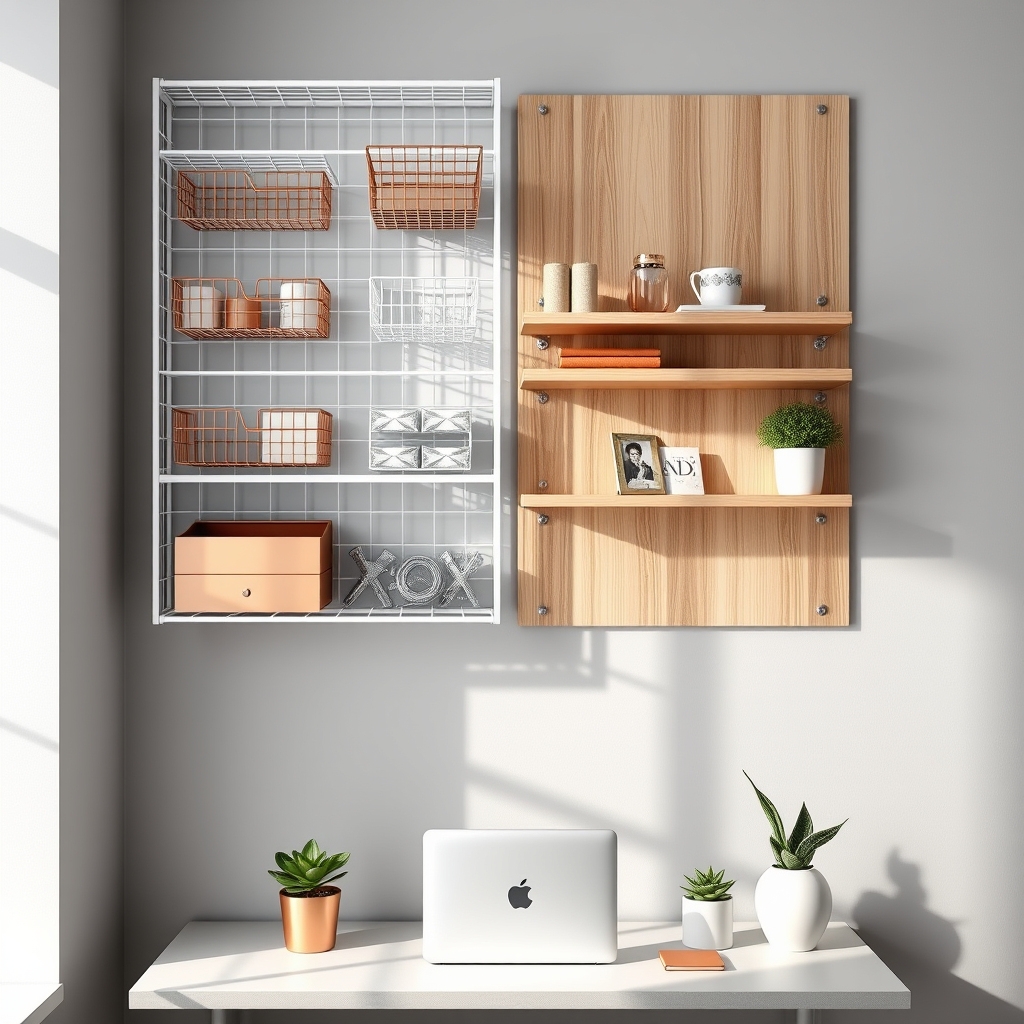
Maximizing vertical space in a home office is essential for maintaining an organized and efficient workspace. Pegboards and wall grid systems offer versatile storage solutions that keep frequently used items visible and easily accessible while freeing up valuable desk and floor space.
These customizable systems have evolved from basic workshop storage to stylish organizational tools that complement modern home office aesthetics. With various accessories and configurations available, pegboards and wall grids can be adapted to store everything from office supplies to tech devices, creating a personalized workflow system that enhances productivity.
Required Items:
- Pegboard or wire grid panels
- Wall mounting hardware
- Wall anchors
- Level
- Drill
- Screwdriver
- Measuring tape
- Pencil
- Hooks (various sizes)
- Baskets
- Shelves
- Cable ties
- Storage bins
- Label maker
Installation begins with measuring your wall space and marking the desired location for your storage system. Mount furring strips or spacers to create a gap between the wall and pegboard, ensuring hooks can be properly inserted. Secure the pegboard or grid system to the wall using appropriate anchors and screws, checking for level placement.
For wire grids, connect multiple panels if needed using provided clips or connectors. Once mounted, organize items by frequency of use and type. Position frequently accessed items at eye level and group similar items together. Install hooks, shelves, and accessories according to your planned layout, ensuring each component is securely fastened.
Consider creating zones for different activities: a supply station, tech charging area, and paper management section. For optimal organization, incorporate clear containers to group small items, use labels for easy identification, and maintain flexibility in your setup by regularly reassessing and adjusting the layout based on changing needs.
Leave some empty space for future additions and rotate seasonal items as needed. Consider adding LED strip lighting to illuminate your organizational system, making it both functional and visually appealing.
Mobile Storage Carts and Rolling Organizers

Mobile storage solutions have become essential components of modern home offices, offering flexibility and adaptability in increasingly dynamic work environments.
These versatile pieces allow you to maximize space efficiency while keeping necessary supplies and documents within arm’s reach, regardless of where you choose to work within your home.
The beauty of mobile storage carts and rolling organizers lies in their ability to transform any space into a functional work area.
Whether you’re working from a dedicated home office or need to transition between different rooms throughout the day, these organizational tools ensure your essentials move with you while maintaining order and accessibility.
Required Items:
- Multi-tier rolling cart
- Clear storage containers
- Label maker
- Drawer organizers
- File folders
- Drawer dividers
- Cable ties
- Small bins or baskets
- Hanging file systems
- Container liners
Begin by categorizing your supplies and materials based on frequency of use and type.
Designate specific tiers or drawers for different categories: frequently used items on top levels, occasional-use items in middle sections, and rarely accessed materials at the bottom.
Install drawer organizers or small containers within each level to prevent items from shifting during movement.
Use clear containers whenever possible to maintain visibility of contents.
Implement a color-coding system for different types of materials, and apply labels clearly to each section.
Ensure heavier items are stored in lower tiers to maintain cart stability.
Configure your filing system within designated drawers using hanging folders and categorical dividers.
Bundle and secure any cables or electronic accessories using cable ties, storing them in dedicated containers to prevent tangling.
Additional Tips:
Maintain the organization system by regularly auditing contents and removing unnecessary items.
Consider adding wheel locks to prevent unwanted movement, and use container liners to protect surfaces and reduce noise.
Keep a small inventory list attached to the cart for quick reference, and establish a regular cleaning schedule to prevent dust accumulation and maintain professional appearance.
Desktop Accessories and Space-Saving Tools
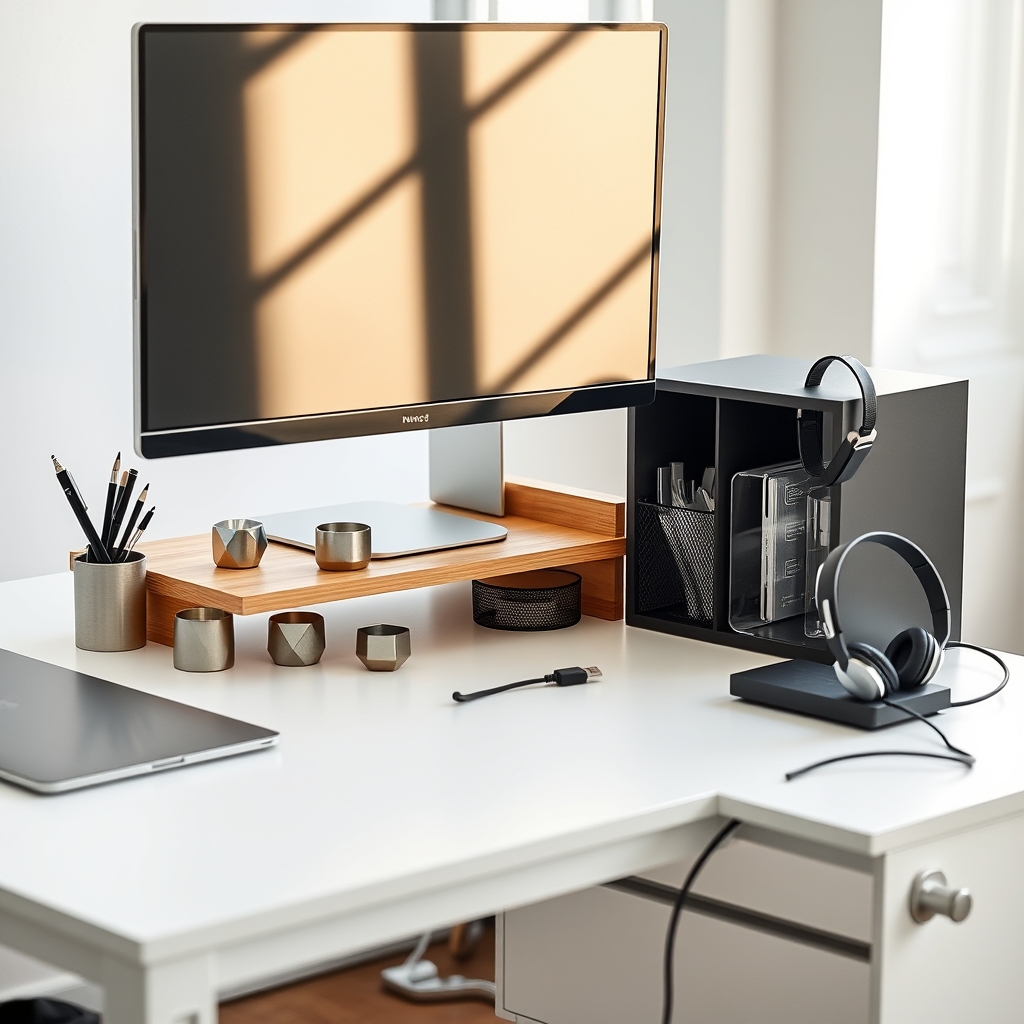
A well-organized desktop is fundamental to maintaining productivity and mental clarity in your home office. When accessories and tools are thoughtfully arranged, you spend less time searching for items and more time focusing on important tasks, ultimately reducing stress and increasing work efficiency.
Desktop organization goes beyond mere aesthetics; it’s about creating a functional system that maximizes your available space while keeping essential items within reach. Smart organization of accessories and space-saving tools can transform even the smallest desk area into an efficient workstation that supports your daily workflow.
Required Items:
- Monitor stand or riser
- Cable management clips/ties
- Desk organizer tray
- Vertical file holder
- Drawer dividers
- Desktop shelf unit
- Pen/pencil holder
- Small containers for paper clips/pins
- Wire basket
- Label maker
- Command hooks
- USB hub
Start by clearing your entire desktop and sorting items into categories: frequently used, occasionally used, and rarely used. Position your monitor at eye level using a stand or riser, which creates valuable storage space underneath.
Install cable management solutions to keep wires tidy and prevent desk clutter. Place frequently used items within arm’s reach in designated zones: writing tools to your dominant side, documents in vertical files, and technology accessories near your devices.
Create a second tier of storage using a desktop shelf unit for items needed weekly but not daily. Utilize drawer dividers to compartmentalize smaller items and prevent them from mixing. Mount command hooks on the sides of your desk or shelf unit for headphones, bags, or other hanging items.
Position your USB hub in an easily accessible location to minimize cable chaos.
Additional Tips:
Implement a weekly maintenance routine to prevent clutter accumulation. Keep only one of each type of tool on your desk (one pen, one highlighter, etc.) and store backups in drawers.
Use clear containers to easily identify contents, and maintain a “one-in-one-out” policy when acquiring new desk accessories. Consider scanning documents to reduce paper clutter and maximize physical space.
Door-Mounted and Behind-Door Storage Options
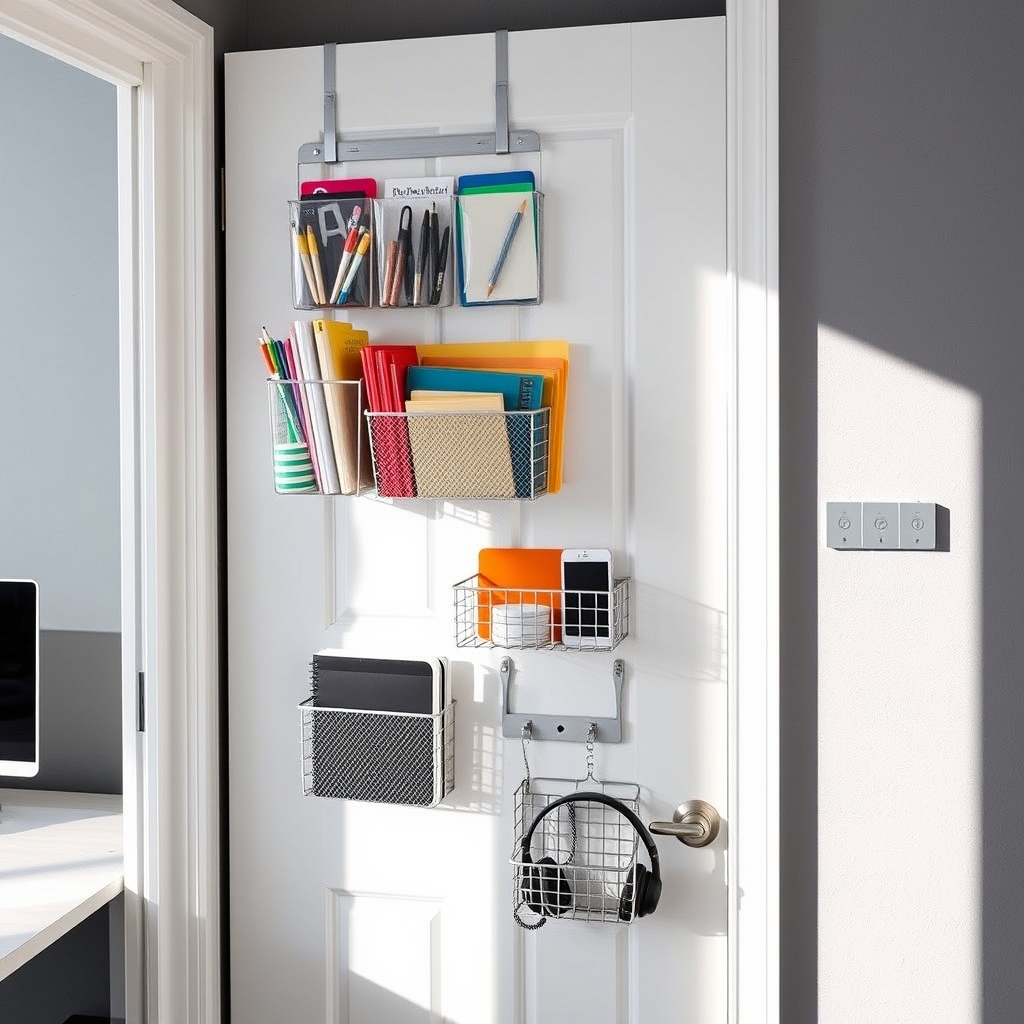
Maximizing every inch of space in a home office is crucial for maintaining productivity and organization, especially in smaller spaces. Door-mounted and behind-door storage systems offer valuable vertical storage opportunities that are often overlooked, turning unused door space into functional storage areas.
Door storage solutions are particularly effective for home offices as they keep frequently used items within arm’s reach while keeping them off valuable desk and shelf space. This storage method is ideal for storing office supplies, files, electronics, and other work essentials without taking up precious floor space.
Required Items:
- Over-the-door organizer with clear pockets
- Command hooks or mounting hardware
- Door-mounted wire baskets
- Measuring tape
- Level
- Screwdriver
- Wall anchors
- Door-mounted file holder
- Storage bins or containers
- Label maker or labels
Start by measuring your door’s dimensions, including width and available hanging space, ensuring any storage solutions won’t interfere with door closure. Install an over-the-door organizer at the top of the door, securing it properly to prevent swinging. For additional stability, consider adding command strips at the bottom corners.
Next, mount wire baskets or file holders at comfortable reaching height, spacing them evenly for visual appeal and practical access. Use proper mounting hardware and wall anchors if drilling into the door is necessary. Organize items by category, placing frequently used supplies in easily accessible pockets or baskets.
Additional Tips:
Consider weight distribution when loading storage solutions, keeping heavier items at lower levels. Use clear storage containers to easily identify contents, and implement a labeling system for maximum efficiency.
Regularly audit stored items to prevent accumulation of unnecessary materials, and adjust the organization system as your needs change. Remember to periodically check mounting hardware to ensure everything remains secure and safe.

